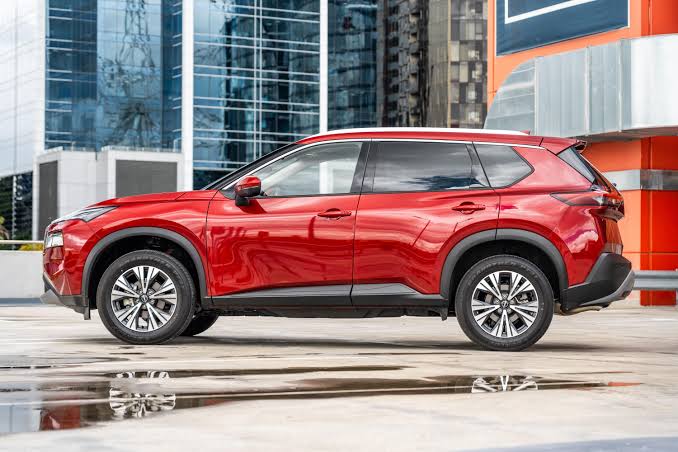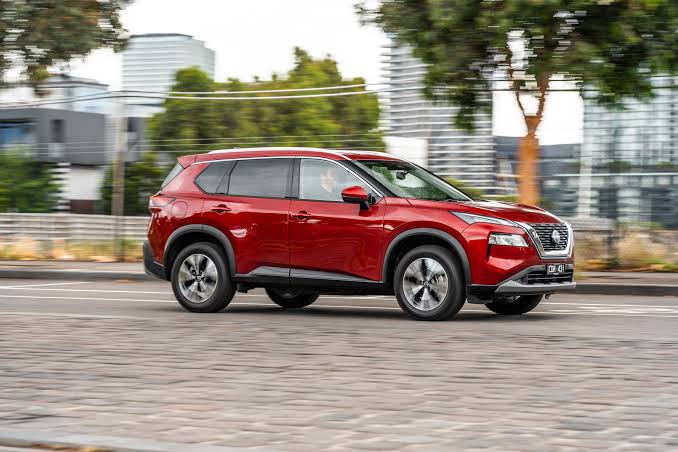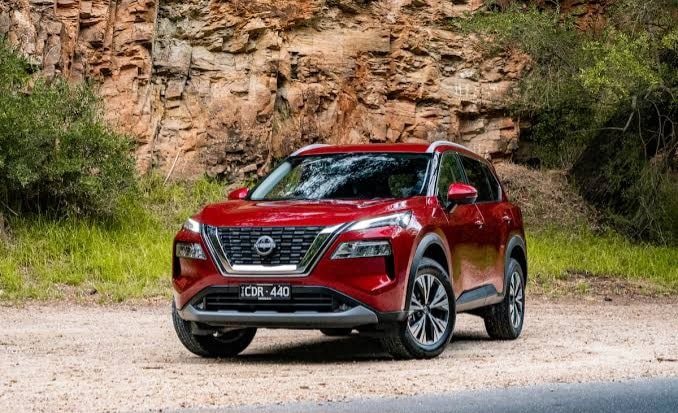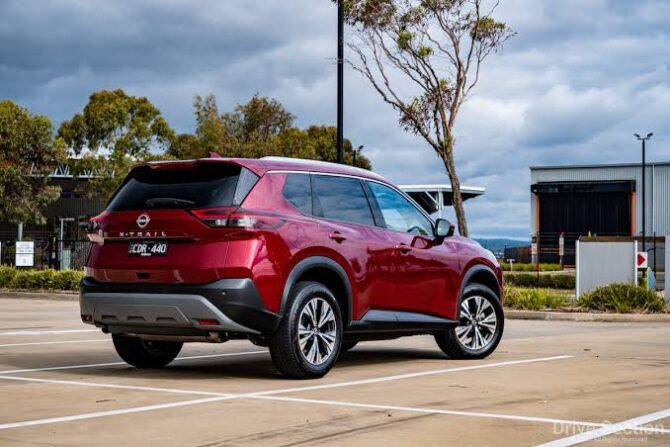Over the years, the X-Trail has changed considerably from its predecessors. It now features an unban crossover attitude instead of a robust style. The fourth-generation X-Trail features more aggressive design cues and a sharper look. It has two split LED headlights up front, which are placed on either side of Nissan’s “V motion” grille. LED DRLs with halogen turn indicators are added to the top. Headlights with reflectors are mounted on the lower portion. Nissan’s new emblem, which is perched atop the front parking camera, is displayed on the V-motion grille. Front parking sensors, a skid plate with a silver finish, and housing for fog lights are all found on the bumper’s bottom portion. However, these elements were not present on the exhibition vehicle.
The Nissan X-Trail features a flowing side profile that is matched by a sloping roof line. The gloss-black window line sweeps upward and connects with the upper window garnish before continuing straight to the C-pillar. To increase the X-butch Trail’s look, Nissan added copious amounts of body cladding to the wheel arches and door ends. It is important to note that the side sills go all the way to the bottom of the doors, protecting the frame from mud and dust. The X-Trail also has 18-inch alloy wheels with 235/60 R18 tyres as standard equipment. Also, it receives sizable ORVMs with surround vision cameras, side turn indicators, and blind spot detection.

The X-Trail receives spoiler extenders to give it a coupe-like appearance in the rear profile, speaking of which. The car that was on show was an imported model with tinted windows, it is important to note. Due to Indian laws, the model built for India will not feature darkly tinted glass. Split LED taillights with halogen-based turn indicators and a reverse parking light are standard on the X-Trail. Due to the battery pack hidden beneath the fake floor, the boot opening is broad yet the boot lacks depth. Moreover, the X-Trail has a small storage compartment and a puncture repair kit hidden beneath the floor.
Overall, the X-assertive Trail’s look is a breath of fresh air in the sector. But, compared to other SUVs, like the Tata Harrier, which feels more robust, it still feels more at home in the urban jungle. In terms of road presence, it will be interesting to see how it compares to the Jeep Compass, Citroen C5 Aircross, and Hyundai Tucson.
Interior Design for the 2023 Nissan X-Trail
The Nissan X-interior Trail’s features a multi-layer dashboard that makes good use of premium materials and sensitive touch areas. The lower portion of the dashboard has a brushed metallic garnish that spans its width, while the centre bolster is covered in soft stitched leather. A 12.3-inch touchscreen infotainment system is mounted on the dash. Together with compatibility for Apple CarPlay and Android Auto, it provides clear images. A 12.3-inch digital instrument cluster with many levels of customization and viewing possibilities is also included in the X-Trail. Important information is projected on the windscreen using a 10.8-inch head-up display in combination with it.

Nissan’s innovative flat-bottom steering wheel with steering-mounted buttons for media, phone, and ADAS is also available on the X-Trail. The gear selector, hybrid powertrain controls, engine start/stop button, drive mode select, cup holders, and a split-opening centre armrest are all located on the centre console. The cushioning on the door cards and the seats in the display car were both made of fabric. We anticipate that the X-Trail will make up for these flaws and have a tonne more features when it reaches our shores. Several options, including a panoramic sunroof, heated seats, motorised seat adjustment for the driver and passenger, and three-zone climate control, were absent from the exhibition car.
The X-Trail has plenty of legroom and footroom in the second row. That isn’t the greatest in its class, though. The lack of a panoramic sunroof also makes the headroom feel more than enough. The X-second Trail’s row seats have a split of 40:20:40 and can move and recline. Two cup holders, a smartphone storage space, and a centre armrest are all included in the second row’s middle backrest. The big glass area of the back doors and the addition of sunblinds enhance the backseat experience even further. The Nissan X-Trail also has a third row option, but it wasn’t present in the show vehicle, and it’s unclear whether it will be.
Hybrid 2023 Nissan X-Trail
Nissan picked the e:power strong hybrid powertrain for our market out of the two available engines for the X-Trail in other areas. A potent hybrid drivetrain is included with the 1.5L turbocharged petrol engine in the X-Trail e:power.
The Nissan X-Trail e:power offers the best power output in its class with the 2WD option, producing 204PS at 4600rpm. On the other hand, the 330Nm of torque output is less than that of the Mahindra XUV700. Rear-axle electric motor added to the X-Trail 4WD boosts torque by 195Nm while increasing power output to 213PS, which is 9PS higher than the X-Trail 2WD.

Even though the performance numbers look good on paper, the X-Trail needs to clarify certain issues. First off, although having class-leading performance, the 1.5L turbo petrol engine that powers the X-Trail sounds little for this class of SUV. Second, we have only contrasted the X-Trail with the petrol-powered SUVs. The Citroen C5 Aircross is the sole SUV that only has a diesel engine, although other SUVs like the Mahindra XUV700, MG Hector, and Hyundai Tucson also have a diesel engine option. Having a diesel engine in this category of SUVs usually has its own bragging rights, even though we have no concerns that the X-Trail will deliver good fuel economy thanks to the potent hybrid powertrain.
What do you think about the X-Trail? Do you believe Nissan should start thinking about assembling the X-Trail locally right away? Enter your ideas and opinions in the space provided below.
ALSO READ THIS : Best family van: New 2023 Ford Tourneo Plug-In

